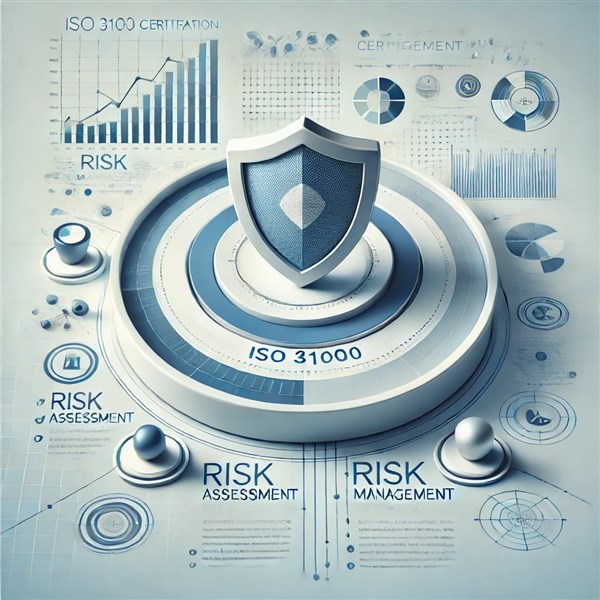
In today’s fast-paced and unpredictable business environment, organizations face a wide range of risks that can affect their operations, finances, and reputations. From cybersecurity threats to economic fluctuations, risk is an inherent part of any business landscape. To navigate these challenges, it’s critical for businesses to have a robust risk management system in place. This is where the ISO 31000 certification comes into play.
ISO 31000 is an international standard for risk management that provides guidelines and best practices for managing risk in a structured and consistent manner. Unlike other risk management frameworks, ISO 31000 is not industry-specific, making it applicable to organizations of all sizes and across various sectors. By obtaining ISO 31000 certification, companies can not only strengthen their risk management processes but also demonstrate their commitment to proactively managing risks to stakeholders. This blog will explore the top reasons why ISO 31000 certification is essential for effective risk management and how it helps organizations navigate uncertainties more confidently.
Reasons Why ISO 31000 Certification is Essential
1. Establishes a Proactive Risk Management Culture
One of the most significant benefits of ISO 31000 certification is that it fosters a proactive approach to risk management rather than a reactive one. Many organizations fall into the trap of managing risks only after they have materialized. ISO 31000 promotes identifying, assessing, and mitigating risks before they turn into actual problems. This mindset shift encourages organizations to continually monitor their environment for potential risks and adapt their strategies accordingly.
By obtaining ISO 31000 certification, organizations can embed risk management into their culture. This ensures that risk considerations become a key part of decision-making processes at every level of the organization. A proactive risk culture also enables organizations to take advantage of opportunities that may arise in uncertain environments.
2. Enhances Decision-Making Processes
Risk management plays a crucial role in decision-making, as it helps organizations weigh the potential impact of various risks on their objectives. ISO 31000 certification provides organizations with a structured framework for evaluating risks and making informed decisions based on risk assessments.
Certified organizations can better analyze risk scenarios and their consequences, allowing decision-makers to have a clearer understanding of the uncertainties involved. This structured approach to decision-making ensures that all options are carefully evaluated, and the most appropriate risk response strategies are selected.
For example, when launching a new product or entering a new market, organizations can use the ISO 31000 framework to assess potential risks, such as competitive pressures, regulatory hurdles, or supply chain disruptions. By incorporating risk assessments into strategic decisions, companies can allocate resources more effectively and minimize the likelihood of failure.
3. Improves Organizational Resilience
In an era of unprecedented disruptions—whether due to technological advancements, natural disasters, or economic crises—organizational resilience is key to long-term success. ISO 31000 certification helps organizations build resilience by identifying potential risks and putting mechanisms in place to address them.
The standard encourages organizations to take a holistic approach to risk management by considering both external and internal factors that could affect their operations. This enables businesses to prepare for a wide range of scenarios, from supply chain interruptions to cyberattacks. As a result, organizations with ISO 31000 certification are better equipped to withstand and recover from unexpected challenges.
Additionally, ISO 31000 emphasizes the importance of continuous improvement in risk management. By regularly reviewing and updating their risk management practices, certified organizations can adapt to evolving risks and emerging threats, ensuring that their risk management systems remain relevant and effective over time.
4. Boosts Stakeholder Confidence
Stakeholders, including customers, investors, and regulatory bodies, are increasingly concerned about how organizations manage risks. A well-documented and certified risk management system, such as the one provided by ISO 31000, can significantly enhance stakeholder confidence. It demonstrates that the organization is serious about identifying and addressing potential risks, thereby protecting its assets, reputation, and long-term viability.
ISO 31000 certification signals to stakeholders that the organization follows internationally recognized best practices for risk management. This can be particularly valuable when dealing with investors who need assurance that their investments are protected or when seeking regulatory approvals in industries with stringent compliance requirements. Moreover, customers are more likely to trust businesses that can demonstrate robust risk management, as it shows a commitment to delivering consistent quality and service.
5. Aligns with Other Management Standards
ISO 31000 is designed to be flexible and can be easily integrated with other management standards, such as ISO 9001 (quality management), ISO 14001 (environmental management), and ISO 27001 (information security management). This alignment allows organizations to create a cohesive management system that addresses various aspects of risk across different domains.
For example, combining ISO 31000 with ISO 27001 can help organizations enhance their cybersecurity risk management processes by identifying vulnerabilities, assessing potential threats, and implementing appropriate controls to safeguard sensitive information. Similarly, integrating ISO 31000 with ISO 9001 ensures that quality-related risks, such as product defects or supply chain disruptions, are properly managed to maintain customer satisfaction.
This compatibility with other standards allows organizations to streamline their risk management efforts, reduce duplication, and improve overall efficiency.
6. Supports Regulatory Compliance
Many industries are subject to strict regulations that require organizations to manage risks effectively. Non-compliance with these regulations can result in severe financial penalties, legal liabilities, and reputational damage. ISO 31000 certification helps organizations meet regulatory requirements by providing a structured framework for risk management that aligns with global standards.
For instance, in the financial services sector, organizations must comply with regulations related to risk management, such as Basel III, which requires banks to maintain adequate capital reserves to mitigate risks. ISO 31000 certification can help financial institutions develop a risk management system that satisfies regulatory requirements while improving operational performance.
Moreover, as regulatory environments become increasingly complex, ISO 31000 certification ensures that organizations can stay ahead of regulatory changes by continuously reviewing and updating their risk management practices.
7. Improves Operational Efficiency
Effective risk management is not only about mitigating negative risks but also about identifying opportunities that can lead to operational improvements. ISO 31000 certification encourages organizations to view risk management as an integral part of their business processes, helping them optimize resource allocation, reduce waste, and improve productivity.
For example, by assessing risks related to supply chain inefficiencies, organizations can identify bottlenecks and implement strategies to streamline operations, reduce costs, and enhance service delivery. Similarly, identifying risks associated with outdated technology can lead to the adoption of new tools and systems that improve overall efficiency.
By embedding risk management into day-to-day operations, certified organizations can achieve greater consistency and reliability in their processes, ultimately leading to better business outcomes.
Conclusion
ISO 31000 certification is a powerful tool for organizations looking to implement effective risk management strategies. From fostering a proactive risk culture to enhancing decision-making and supporting regulatory compliance, the certification provides a comprehensive framework for managing risks in a structured and consistent manner. As businesses continue to navigate an increasingly complex and unpredictable landscape, obtaining ISO 31000 certification can be a key differentiator, helping organizations build resilience, improve stakeholder confidence, and achieve long-term success.
By prioritizing risk management through ISO 31000, organizations can not only protect their assets and reputation but also unlock new opportunities for growth and innovation.
Koenig Solutions, a leading IT training company, provides a comprehensive training course for those seeking to become a certified ISO 31000 Risk Management professional. With expert tutors and flexible learning options, Koenig Solutions is the ideal partner for your professional development journey.







COMMENT